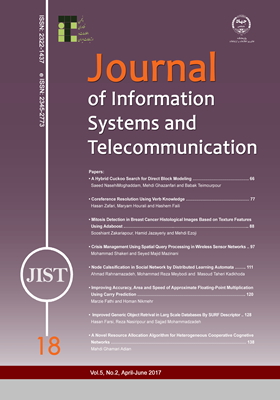-
-
List of Articles
-
Open Access Article
1 - A Hybrid Cuckoo Search for Direct Blockmodeling
Saeed NasehiMoghaddam mehdi ghazanfari babak teimourpour -
Open Access Article
2 - Coreference Resolution Using Verbs Knowledge
hasan zafari maryam hourali Heshaam Faili -
Open Access Article
3 - Mitosis detection in breast cancer histological images based on texture features using AdaBoost
Sooshiant Zakariapour Hamid Jazayeri Mehdi Ezoji -
Open Access Article
4 - Crisis management using spatial query processing in wireless sensor networks
mohammad shakeri seyyed majid mazinani -
Open Access Article
5 - Node Classification in Social Network by Distributed Learning Automata
Ahmad Rahnama Zadeh meybodi meybodi Masoud Taheri Kadkhoda -
Open Access Article
6 - Improving Accuracy, Area and Speed of Approximate Floating-Point Multiplication Using Carry Prediction
Marziye Fathi Hooman Nikmehr -
Open Access Article
7 - Improved Generic Object Retrieval In Large Scale Databases By SURF Descriptor
Hassan Farsi Reza Nasiripour Sajad Mohammadzadeh -
Open Access Article
8 - A Novel Resource Allocation Algorithm for Heterogeneous Cooperative Cognitive Radio Networks
Mehdi Ghamari Adian
-
The rights to this website are owned by the Raimag Press Management System.
Copyright © 2017-2025







